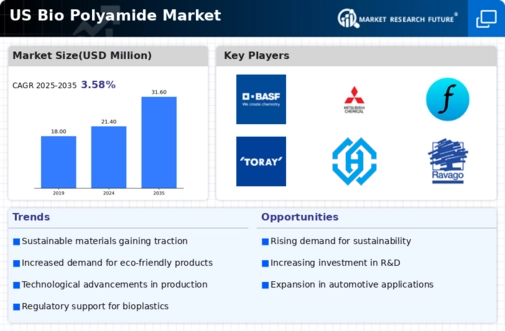The US Bio Polyamide Market is witnessing significant dynamics, influenced by the increasing emphasis on sustainable materials and advancements in technology. As awareness around environmental impact escalates, industries are shifting toward bio-based alternatives, and polyamides made from renewable resources are gaining traction. This market is characterized by a blend of established chemical giants and innovative start-ups, each vying to capture a portion of the growing demand for environmentally friendly materials.
Competitive insights reveal a landscape where companies are investing in research and development to create varied applications that appeal to diverse sectors like automotive, textiles, and consumer goods, catalyzing a race for market share and technological superiority.
BASF
BASF stands out in the US Bio Polyamide Market through its established presence and extensive portfolio of bio-based products. The company leverages its global expertise and invests significantly in innovation, leading to the development of high-performance materials that cater to specific client needs. BASF has committed to sustainability as a core aspect of its strategy, ensuring that its offerings not only meet performance criteria but also align with environmental standards. The company's strong supply chain, robust distribution network, and established relationships with key industries bolster its competitive edge.
Moreover, BASF is known for its ability to respond quickly to market shifts and customer requirements, further solidifying its position as a leader in the US bio polyamide sector.
Kraton Corporation
Kraton Corporation has carved out its niche in the US Bio Polyamide Market with a focus on producing sustainable polymers derived from renewable sources. The company emphasizes innovation through research and development, offering a range of products that cater specifically to the needs of the plastics, coatings, and adhesives industries. Key strengths of Kraton include its advanced technological capabilities and a strong commitment to sustainability, which appeals to environmentally conscious consumers and businesses.
The company has also engaged in strategic mergers and acquisitions to enhance its product offerings and market reach within the US, continually working toward increasing its competitiveness in the bio polyamide segment. The combination of a diverse product lineup and a strategic approach to growth positions Kraton Corporation as a key player in the evolving landscape of bio-based materials in the US market.



















